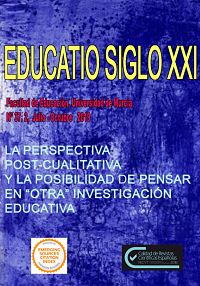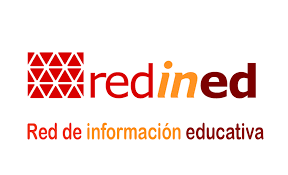Geografías e historias de aprendizaje de docentes de secundaria. Intersecciones, tránsitos y zonas de no saber
Resumen
El artículo muestra parte de los procesos y resultados de un proyecto de investigación que explora qué, cómo, con qué y dónde aprenden los docentes de secundaria dentro y fuera de sus centros. Tras presentar la perspectiva onto-epistemológica en la que se sitúa el estudio y los avances que se propone alcanzar, nos referirnos brevemente a la aproximación metodológica y a los participantes en la investigación. A continuación, nos centramos en ocho docentes que trabajan en uno de los tres ins titutos que han colaborado en el estudio. Para ello, situamos el contexto y los procesos llevados a cabo y realizamos una aproximación a sus geografías e historias de aprendizaje. A continuación, se problematiza el proceso de análisis seguido y se identifican los escenarios en los que aprenden los docentes, los tránsitos entre escenarios y las nociones de aprendizaje que emergen en sus geografías e historias
de aprendizaje. Finalmente, se sitúan las aportaciones que estas prácticas de investigación narrativa pueden representar para la propia investigación educativa y la formación docente.
Descargas
-
Resumen598
-
PDF510
Citas
Arnseth, H.C., y Silseth, K. (2013). Tracing Learning Identity Across Sites: Tensions, Connections and Transformations in and Between Everyday and Institutional Practices. En O. Erstad y J. Sefton-Green (ed.) Identity, community, and learning lives in the digital age. (pp. 23-38). Nueva York: Cambridge.
Atkinson, D. (2011). Art, Equality and Learning: Pedagogies Against the State. Rotterdam: Sense Publishers.
Ball, S. J., y Goodson, I. F. (1985). Teachers' lives and careers. Philadelphia: Falmer Press.
Banks, J. A., Au, K. H., Ball, A. F., Bell, P., Gordon, E. W., Gutiérrez, K., Heath, S. B., Lee, C. D., Lee, Y., Mahiri, J., Nasir, N. S., Valdes, G. I., y Zhou, M. (2007). Learning in and out of school in diverse environments. Life-long, life-wide, life-deep. Seattle. Recuperado de: http://life-slc.org/docs/Banks_etal-LIFE-Diversity-Report.pdf [23.03.2017]
Barad, K. (2007). Meeting the Universe Halfway: Quantum Physics and the Entanglement of Matter and Meaning. Durham: Duke University Press.
Boltanski, L., y Chiapello, È. (2002). El nuevo espíritu del capitalismo. Madrid: Akal.
Bourdieu, P. (1997). Capital Cultural, Escuela y Espacio Social. México, D.F.: Siglo XXI.
Braidotti, R. (2006). Transpositions. On Nomadic Ethics. Cambridge: Cambridge Polity Press.
Braidotti, R. (2014). Writing as a nomadic subject. Comparative Critical Studies, 11(2-3), 163-184.
Bruner, L. (1977). The Relevance of Education. New York: Norton.
Calderhead, J. (ed.) (1987). Exploring Teacher Thinking. London: Cassell.
Carr, M., y Lee, W. (2012). Learning Stories: Constructing Learner Identities in Early Education. London: SAGE.
Darling-Hammond, L., y Richardson, N. (2009). Research Review / Teacher Learning: What Matters?. Educational Leadership, 66(5), 46-53.
Cumming, T. (2015). Challenges of ‘thinking differently’ with rhizoanalytic
approaches: a reflexive account. International Journal of Research & Method in Education, 38(2),137-148.
Deleuze, G., y Guattari, F. (2004). A thousand plateaus. London: Continuum.
Erstad, O. (2015). Learning Lives Across Educational Boundaries: Continuity and Discontinuity in Learning Trajectories. IJREE, 3(2), 9-22.
Escudero, J. M., Cutanda. M. S., y Trillo, F. (2017). Aprendizaje docente y desarrollo profesional del profesorado. Profesorado. Revista de Currículum y Formación del Profesorado, 21(3), 83-102.
Fendler, R. (2013). Becoming-Learner: Coordinates for Mapping the Space and Subject of Nomadic Pedagogy. Qualitative Inquiry, 19(10), 786-793.
Fendler, R. (2015). Navigating the eventful space of learning: Mobilities, nomadism and other tactical maneuvers (Tesis doctoral inédita). University of Barcelona, Barcelona.
Fullan, M. (2016). The new meaning of educational change. New York: Teachers College Press.
Goodson, I. F., y Hargreaves, A. (eds.) (1996). Teachers’ professional lives. London: The Falmer Press.
Goodson, I. F., y Sikes, P. (2001). Life history research in educational settings. Buckingham: Open University Press.
Guattari, F. (2012). Schizoanalytic Cartographies. Bloomsbury: London.
Hargreaves, A. (1994). Changing teachers, changing times: teachers' work and culture in the postmodern age. New York: Teachers College Press.
Jackson, A.Y., y Mazzei, L. (2012). Thinking with theory in qualitative research: Viewing data across multiple perspectives. New York: Routledge.
James, M., y McCormicki, R. (2009). Teachers learning how to learn. Teaching and Teacher Education, 25(7), 973-982.
Korthagen, F. (2017). Inconvenient truths about teacher learning: towards professional development 3.0. Teachers and Teaching: theory and practice, 23(4), 387-405.
Lury, C., y Wakeford. N. (Ed.) (2012). Inventive Methods: The Happening of the Social (Culture, Economy, and the Social). New York: Routledge.
McNamara, D. (2006). Research on Teachers’ Thinking: its contribution to educating student teachers to think critically. Journal of Education for Teaching, 16(2), 147-160.
Miño Puigcercós, R. (2018). Young people’s trajectories in the digital age. Digital Education Review, 33, 39-54.
Mishra, P., y Koehler, M. J. (2006). Technological pedagogical content knowledge: a framework for integrating technology in teacher knowledge. Teachers College Record, 108(6), 101-154.
Phillips, D. C. (2014). Research in the Hard Sciences, and in Very Hard “Softer” Domains. Educational Researcher, 43(1), 9-11.
Putnam, R. T., y Borko, H. (2000). What do new views of knowledge and thinking have to say about research on teacher learning? Educational Researcher, 29(1), 4-15.
Rodrigo, M. J., Rodríguez, A., y Marrero, J. (1993). Las teorías implícitas. Una aproximación al conocimiento cotidiano. Madrid: Visor.
Ruitenberg, C. (2007). Here be dragons: Exploring Cartography in Educational Theory and Research. Complicity: An International Journal of Complexity and Education, 4, 7-24.
Sancho, J. (Coord.), (2011). Con voz propia. Los cambios sociales y profesionales desde la experiencia de los docentes. Barcelona: Octaedro.
Sancho, J. (Coord.) (2013). Trayectorias docentes e investigadoras en la universidad. 24 historias de vida profesional. Barcelona: Dipòsit Digital de la Universitat de Barcelona. Recuperado de: http://hdl.handle.net/2445/44965 [13.03.2018]
Sancho, J. y Hernández, F. (2014). Maestros al vaivén. Aprender a ser docente en el mundo actual. Barcelona: Octaedro.
Sarason, S. (1990). The predictable failure of educational reform: can we change course before it's too late? San Francisco: Jossey-Bass.
Sefton-Green, J. (2017). Representing learning lives: what does it mean to map learning journeys? International Journal of Educational Research, 84, 111-118.
Shulman, L. S. (1987). Knowledge and teaching: Fundaments of the new reform. Harvard Educational Review, 57(1), 1-22.
Shulman, L. S. y Shulman, J. H. (2004). How and what teachers learn: a shifting perspective. Journal of Curriculum Studies, 36(2), 257-271.
Stenhouse, L. (1975). An introduction to curriculum research and development. London: Heinemann.
Stoll, L., y Fink, F. (1996). Changing Our Schools: Linking School Effectiveness and School Improvement. Buckingham: Open University Press.
Tenti, E. (2010). Configuraciones sociales y culturales de estudiantes y docentes de los ISFD: algunas claves interpretativas. En E. Tenti (coord.), Estudiantes y profesores de la formación docente: opiniones, valoraciones y expectativas (pp. 11-34). Buenos Aires: Ministerio de Educación de la Nación.
Ulmer, J. B., y Koro-Ljungberg, M. (2015). Writing Visually Through (Methodological) Events and Cartography. Qualitative Inquiry, 21(2), 138-152.
Vélaz de Medrano, C., y Vaillant, D. (Coord.) (2009). Aprendizaje y desarrollo profesional docente. Madrid: OEIA/Fundación Santillana.
Warf, B., y Arias, S. (eds.) (2008). The Spatial Turn: Interdisciplinarity Perspectives. New York: Routledge.
Las obras que se publican en esta revista están sujetas a los siguientes términos:
1. El Servicio de Publicaciones de la Universidad de Murcia (la editorial) conserva los derechos patrimoniales (copyright) de las obras publicadas, y favorece y permite la reutilización de las mismas bajo la licencia de uso indicada en el punto 2.
2. Las obras se publican en la edición electrónica de la revista bajo una licencia Creative Commons Reconocimiento-NoComercial-SinObraDerivada 4.0 Internacional (texto legal). Se pueden copiar, usar, difundir, transmitir y exponer públicamente, siempre que: i) se cite la autoría y la fuente original de su publicación (revista, editorial y URL de la obra); ii) no se usen para fines comerciales; iii) se mencione la existencia y especificaciones de esta licencia de uso.
3. Condiciones de auto-archivo. Se permite y se anima a los autores a difundir electrónicamente las versiones pre-print (versión antes de ser evaluada) y/o post-print (versión evaluada y aceptada para su publicación) de sus obras antes de su publicación, ya que favorece su circulación y difusión más temprana y con ello un posible aumento en su citación y alcance entre la comunidad académica. Color RoMEO: verde.











